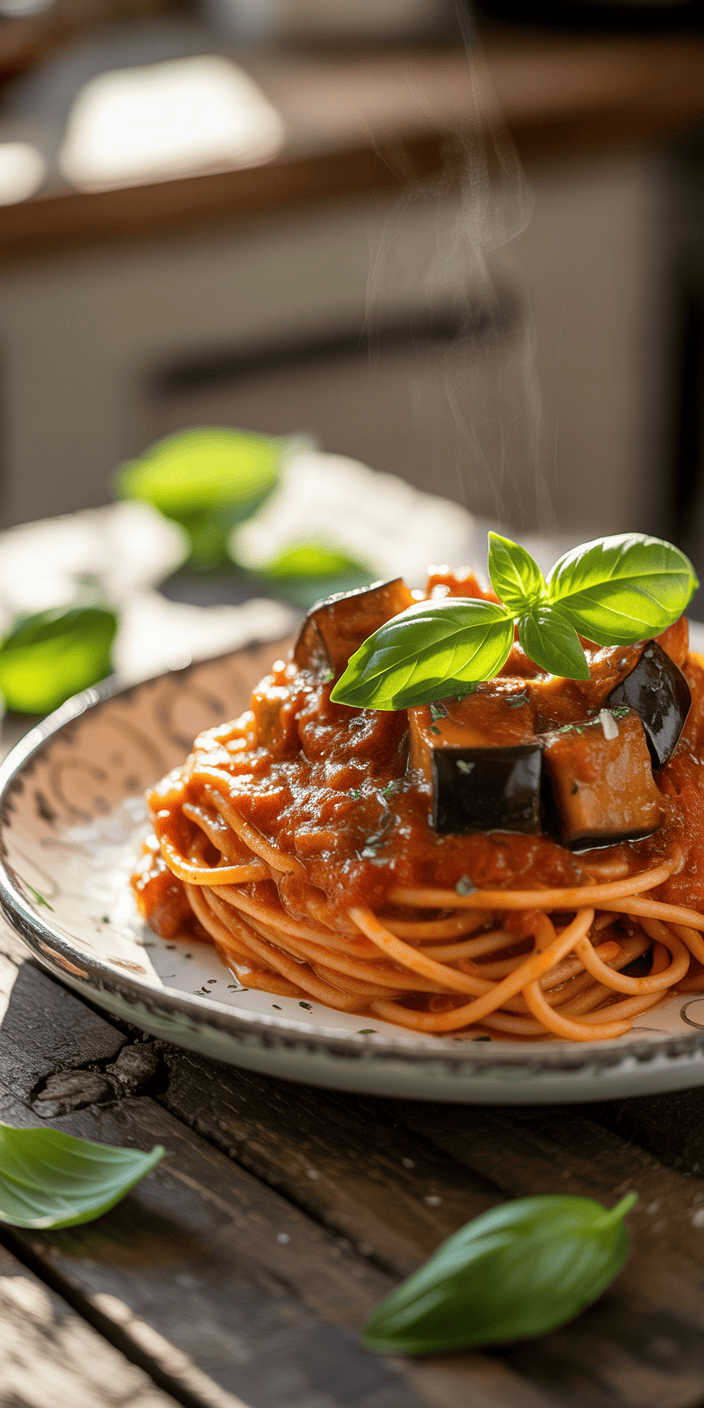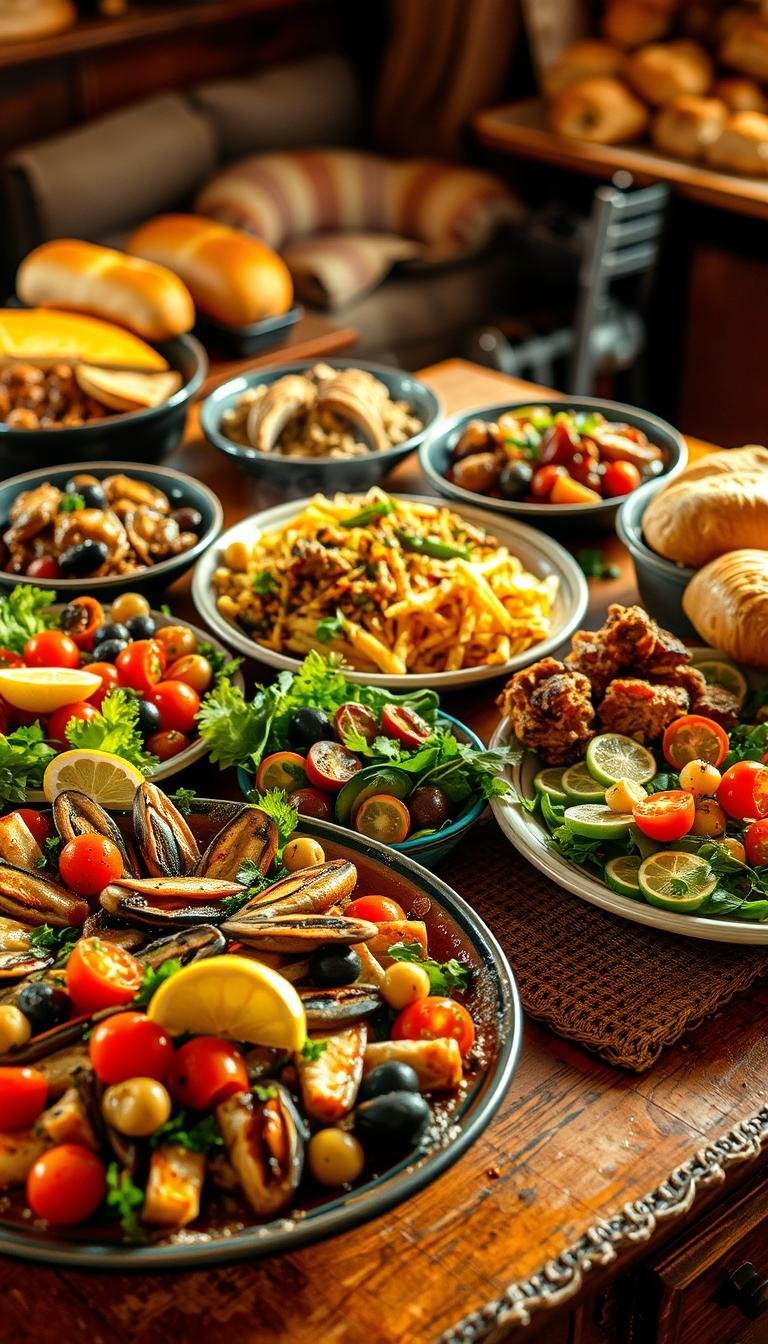(Hey! Some links in this post may be affiliate links — meaning I may earn a small commission if you buy through them, at no extra cost to you. As an Amazon Associate, I earn from qualifying purchases. I only share products I genuinely love and think you’ll find useful too. Read the full disclosure here).
The Mediterranean Diet is more than a trend. It’s a centuries-old way of eating. This Mediterranean Diet guide makes it easy for beginners. It shows how it’s a lifestyle that boosts health and energy.
Millions around the world follow it. They love its focus on whole foods like olive oil, fish, and fresh veggies.
If you’re new to cooking or want a healthier diet, this Mediterranean Diet For Beginners guide is for you. It teaches you how to shop, plan meals, and enjoy flavors from Greece, Italy, and Spain. This Mediterranean Diet basics guide makes it simple for anyone to start. It proves you can eat well without strict rules or special diets.
Contents
- 1 What is the Mediterranean Diet?
- 2 Health Benefits of the Mediterranean Diet
- 3 Key Components of the Mediterranean Diet
- 4 How to Get Started with the Mediterranean Diet
- 5 Sample Mediterranean Diet Meal Plan
- 6 Common Misconceptions about the Mediterranean Diet
- 7 Adjusting the Mediterranean Diet for Your Lifestyle
- 8 Tips for Staying on Track
- 9 Cooking Techniques for Mediterranean Cuisine
- 10 Popular Mediterranean Dishes to Try
- 11 Grocery Shopping for the Mediterranean Diet
- 12 Resources for Further Learning
What is the Mediterranean Diet?
The Mediterranean Diet comes from the eating habits of Greece, Italy, and Spain. It’s a way of life that focuses on healthy foods for better health and longer life. It’s not about cutting out foods, but finding balance and enjoying what you eat.
Overview of the Mediterranean Diet basics
This diet puts plants first. Think vegetables, fruits, whole grains, and legumes. These are the main foods in your meals. Olive oil is used instead of unhealthy fats.
Dairy, fish, and poultry are eaten in small amounts. Red meat is rare. But, processed foods and sugars are kept to a minimum.
Core Principles and Foods Included
Here are the key rules of the Mediterranean Diet:
- Plenty of plants: Eat 7-10 servings of vegetables and fruits every day.
- Healthy fats: Olive oil is your go-to fat. Nuts and seeds are good too.
- Seafood focus: Have fish twice a week for omega-3s.
The Mediterranean Diet food list includes:
- Whole grains like oats and barley
- Beans and lentils
- Fresh herbs like basil and oregano
“This diet isn’t about rules—it’s about savoring nutritious, flavorful foods,” says the American Heart Association.
Switching to this diet means choosing grilled fish over red meat. Snack on olives or fruit instead. Small changes can lead to big health improvements.
Health Benefits of the Mediterranean Diet
Science proves the Mediterranean Diet is more than a meal plan. It’s a path to lasting health. These benefits can change your life today.

Heart Health Improvements
Studies show this diet can lower heart disease risk by up to 30%. Foods like olive oil, nuts, and fish with omega-3s help. They reduce bad cholesterol and fight inflammation.
Antioxidants in berries and greens protect arteries. The Mediterranean Diet benefits also include better blood pressure and lower stroke risk.
Weight Management Advantages
Forget about restrictive diets. The Mediterranean Diet weight loss approach keeps you full naturally. Foods like beans and whole grains slow digestion.
Protein from fish and legumes stops hunger. Research in the New England Journal of Medicine shows weight loss without counting calories. Key factors:
- Fiber-rich foods curb cravings
- Healthy fats boost metabolism
- Portion control through nutrient density
Enhanced Longevity and Quality of Life
People in Mediterranean “Blue Zones” live longer thanks to this diet. Antioxidants slow aging, and plant-based eating reduces diabetes and cancer risks. Cognitive studies show a 19% lower Alzheimer’s risk.
This lifestyle isn’t just about living longer. It’s about thriving into older age.
Key Components of the Mediterranean Diet
Learning about the Mediterranean Diet basics begins with its main parts. This diet focuses on whole, nutrient-rich foods. These foods are the heart of the Mediterranean Diet food list. They help keep you energized, support heart health, and make meal planning easier. Let’s dive into each key part of this diet.
Healthy Fats: Olive Oil and Nuts
Swap butter and margarine for olive oil, the diet’s key. Use it raw in salads or for cooking at low heat to keep its good stuff. Nuts like almonds and walnuts bring healthy fats and crunch. Enjoy a small handful each day as snacks or toppings.
Fruits and Vegetables: Importance and Variety
Colorful fruits and veggies are the base of every meal. Aim for 7-10 servings a day. Here are some great options:
- Leafy greens (spinach, arugula)
- Bright berries (strawberries, pomegranates)
- Crisp cruciferous vegetables (broccoli, cauliflower)
Seasonal fruits like citrus and stone fruits add sweetness without sugar.
Whole Grains: Choosing the Right Options
Choose whole grains like barley, quinoa, and farro over refined carbs. Look for “100% whole grain” labels to get the most fiber. These grains keep your energy steady, preventing midday slumps.
Starting your Mediterranean Diet food list is easy with these basics. Focus on fresh foods and simple preparation. Small changes, like using olive oil on salads or choosing bulgur over white rice, make it easy to follow.
How to Get Started with the Mediterranean Diet
Switching to the Mediterranean Diet doesn’t mean you have to change your whole life. Start with small, easy steps. Use this Mediterranean Diet guide for beginners.
Selecting Your Staple Ingredients
Fill your pantry with must-haves for easy meal making. Key items include:
- Olive oil: Choose extra-virgin for cooking and dressings
- Whole grains: Opt for quinoa, farro, or brown rice
- Canned beans and lentils: Quick protein sources like chickpeas or cannellini beans
- Herbs & spices: Basil, oregano, and garlic powder add flavor without salt

Planning Your Weekly Meals
Start with a 3-step plan:
- Choose two meatless days weekly (try bean-based soups or salads)
- Prep grains and proteins in advance (cook a big batch of quinoa or grilled veggies)
- Pair meals with fresh fruits for desserts (think berries or apple slices)
“Start with one Mediterranean meal a day, then expand to full-day plans,” advises registered dietitian Lisa Davis. “Progress, not perfection, builds lasting habits.”
Slowly replace processed snacks with nuts, yogurt, or veggie sticks. This How to start Mediterranean Diet way helps you build up without feeling overwhelmed. Keep your pantry full and your schedule open for trying new things!
Sample Mediterranean Diet Meal Plan
Starting with the Mediterranean Diet or need some ideas? This Mediterranean Diet meal plan has tasty, easy recipes. They use fresh ingredients and are quick to make, great for when you’re in a rush.
Breakfast Ideas
Begin your day with:
- Greek yogurt with honey, walnuts, and pomegranate seeds
- Whole grain toast, mashed avocado, cherry tomatoes, and chili flakes
- Whole egg frittata with spinach, feta, and red pepper strips
Need some tasty breakfast inspiration? These Mediterranean-style ideas are a great way to kick off your day. Want even more options? Check out our full list of healthy Mediterranean diet breakfast recipes!
Lunch Suggestions
For quick lunches:
- Quinoa bowls with chickpeas, cucumber, olives, and lemon-tahini dressing
- Chickpea salad in a whole grain pita with lettuce and hummus
- Zucchini noodle “pasta” with cherry tomatoes, basil, and olive oil
Lunchtime doesn’t have to be boring—these Mediterranean-inspired ideas are perfect when you’re short on time but still want something tasty. Craving more meal inspo? Don’t miss our roundup of 20 delicious Mediterranean diet recipes.
Dinner Options
For family dinners:
- Grilled salmon with roasted asparagus and brown rice
- Vegetable lasagna with zucchini, marinara, and part-skim mozzarella
- Lentil stew with carrots, tomatoes, and whole grain bread
Looking for easy and wholesome dinner ideas the whole family will love? These Mediterranean-style meals are packed with flavor and goodness. For more tasty options, check out our favorite Mediterranean diet dinner ideas.
Make recipes your own—try chicken instead of fish, or add new veggies. These Mediterranean Diet recipes show the diet is easy to follow in any kitchen. Eat whole foods and a bit of healthy fats to keep on track without strict rules.
“The Mediterranean Diet isn’t about perfection—it’s about balance. Swap one ingredient at a time and enjoy the flavors,” says registered dietitian Maria Lopez of the Mediterranean Nutrition Society.
Common Misconceptions about the Mediterranean Diet
Starting the Mediterranean Diet For Beginners might seem tough. But, myths about cost and strict rules are easy to debunk. Let’s set the record straight about this easy-to-follow diet.

Myth: It’s Too Expensive
Fresh fish and olives might seem pricey. But, smart shopping keeps costs down. Here are some tips:
- Buy seasonal produce and frozen fruits/veggies for year-round savings
- Use canned beans and chickpeas as budget-friendly protein
- Invest in bulk grains like brown rice and oats for staple meals
Myth: It’s Strict and Hard to Follow
The Mediterranean Diet basics focus on balance, not strict rules. Enjoy these freedoms:
- Customize meals with favorite flavors and cultural twists
- Enjoy occasional treats without guilt – it’s about sustainable habits
- Focus on whole foods without cutting out entire food groups
Remember, this diet fits your life, not the other way around. Start small and build gradually. Even one meal at a time is a great start!
Adjusting the Mediterranean Diet for Your Lifestyle
The Mediterranean Diet is all about being flexible. It fits well with different tastes and lifestyles. Start by finding what works best for you.
Vegetarian and Vegan Adaptations
For those who prefer plants, try using legumes like lentils and chickpeas. Replace dairy with olive oil, tahini, and nut cheeses. Focus on fresh veggies and whole grains for a balanced diet. Here are some ideas:
- Tempeh or tofu in grain bowls for protein
- Chickpea pasta as a pasta substitute
- Flaxseeds for omega-3s in vegan meals
Family-Friendly Meal Planning
“Cooking together builds habits. Let kids chop veggies for salads—they’ll eat what they create.” – Nutritionist, Healthy Living Magazine
Start with small changes in your meals. Use whole-grain crusts for pizzas and add roasted veggies. Offer hummus with veggie sticks for snacks. Make meals colorful to get kids excited.
Get everyone involved in meal planning. Let kids pick a veggie each week. Small steps can lead to big changes in your family’s eating habits.
Tips for Staying on Track
Sticking to the Mediterranean Diet is about building habits that feel natural. A Mediterranean Diet guide helps beginners track their progress without feeling overwhelmed. Small steps, like writing down meals or sharing recipes with friends, make it easier to succeed in the long run.

Keeping a Food Journal
- Track meals in a notebook or app to spot trends, like when you crave unhealthy snacks.
- Note how foods make you feel—energy spikes after salads or sluggishness after processed foods.
- Focus on celebrating wins, like trying a new vegetable, instead of counting calories.
Joining a Support Group or Community
Connecting with others makes changes stick. Online forums like Mediterranean Diet For Beginners Facebook groups offer recipe swaps and encouragement. Local cooking classes or potlucks let you share dishes and stay motivated.
“Cooking with friends turns meals into social events, not chores.”
Remember, flexibility is key. A slip-up isn’t failure—just a chance to adjust and try again. Every small choice moves you closer to balanced, joyful eating.
Cooking Techniques for Mediterranean Cuisine
Learning simple cooking methods brings out the bright flavors of the Mediterranean Diet basics. These techniques make meals both healthy and tasty, without adding too much complexity.
Grilling and Roasting
Grilling and roasting bring out the best in food. Toss veggies like zucchini or eggplant with olive oil, garlic, and lemon before grilling. For fish, like salmon or white fish, cook at 400°F for 12-15 minutes. Try these methods in Mediterranean Diet recipes like roasted vegetable platters or skewered cherry tomatoes.
- Marinate proteins in olive oil, lemon, and herbs for 30 minutes before grilling.
- Roast root vegetables at 400°F until caramelized, about 25-30 minutes.
Incorporating Fresh Herbs and Spices
Herbs like basil, oregano, and rosemary add bold taste without salt. Keep a small herb garden or buy fresh bunches weekly. Try these combinations:
- Oregano + garlic for tomato-based dishes
- Basil in summer salads or pesto
- Rosemary with roasted potatoes or lamb
Start with a core set: oregano, thyme, and parsley. Sprinkle dried herbs near the end of cooking to preserve flavor.
Popular Mediterranean Dishes to Try

Exploring classic Mediterranean dishes is a fun way to embrace this healthy lifestyle. Start with simple Mediterranean Diet recipes that highlight fresh ingredients. Try Greek salad with crisp veggies and tangy feta, or creamy hummus made from blended chickpeas and tahini. Ratatouille, a colorful vegetable stew, and light minestrone soup are also perfect for beginners.
- Greek Salad: Combine tomatoes, cucumbers, red onions, Kalamata olives, and feta with olive oil dressing.
- Hummus: Blend chickpeas, tahini, garlic, and lemon juice for a protein-packed dip.
- Ratatouille: Sauté eggplant, zucchini, and bell peppers with herbs like thyme and rosemary.
Regional Variations to Explore
From Spain to Lebanon, Mediterranean flavors vary. Try Mediterranean Diet meal plan ideas like:
- Paella: A Spanish rice dish with saffron, seafood, and peppers.
- Tagine: Slow-cooked Moroccan stew with dried fruits and spices.
- Tabbouleh: Fresh parsley and bulgur salad from Lebanon.
- Cioppino: Italian-inspired fish stew with tomatoes and herbs.
“Every bite tells a story—of tradition, ingredients, and wellness.” — Mediterranean culinary philosophy
These dishes use local ingredients while sticking to Mediterranean principles. Mix them into your weekly meal plan for variety. Whether cooking Greek or Italian-inspired meals, the focus stays on whole foods and flavor.
Grocery Shopping for the Mediterranean Diet
Starting the Mediterranean Diet is easier with a well-stocked pantry. Here’s how to get started and make the transition smoother.
Essential Foods to Stock Up On
Stock your pantry with these key items:
- Oils & Vinegars: Choose extra virgin olive oil (e.g., Colavita) and mix balsamic and red wine vinegar.
- Herbs & Spices: Keep dried oregano, basil, and garlic powder. Fresh mint or parsley adds flavor.
- Grains & Legumes: Use quinoa, farro, and canned chickpeas. Bob’s Red Mill offers affordable whole grains.
- Frozen & Fresh Produce: Freeze berries and spinach for smoothies. Buy seasonal veggies like zucchini or eggplant weekly.
Smart Shopping Tips for Beginners
Follow these tips to stay on track:
- Read labels for hidden sugars. Choose plain Greek yogurt (Fage) and avoid flavored varieties.
- Buy in bulk: Lentils and nuts like almonds from Costco save money long-term.
- Stick to a grocery list to avoid impulse buys. Prioritize seasonal produce for better prices.
“Quality olive oil and fresh herbs make all the difference,” says a Mediterranean dietitian. “Prioritize these staples first.”
Starting the Mediterranean Diet doesn’t mean changing everything at once. Start with small swaps and smart choices. Mix whole grain pasta (Barilla) with new ingredients. Over time, your pantry will reflect this healthy lifestyle naturally.
Resources for Further Learning
Expand your knowledge of the Mediterranean Diet with these helpful resources. They are designed to support your journey. Whether you’re looking for recipes or scientific guidance, these tools offer steps to keep you on track.
If you’re as passionate about the Mediterranean lifestyle as I am, you’ll love these books — packed with inspiration, recipes, and practical advice.
Cookbooks and Blogs
Start with The Mediterranean Diet: A Clinician’s Guide by Dr. Steven Nissen for a science-focused view. For meals your family will love, check out Olive Trees and Honey by Susan Spungen. It has kid-friendly dishes.
For quick recipes and weight loss tips, visit The Mediterranean Dish and EatingWell. Healthline also offers easy-to-understand health benefits guides.
Online Communities and Forums
Join the Mediterranean Diet Foundation community for expert advice and meal plans. Facebook groups like the Mediterranean Diet Community share recipes and tips. They’re great for beginners.
Stay updated with Harvard T.H. Chan School of Public Health’s research summaries. They show how this diet helps heart health and weight management.
These resources turn curiosity into action, helping you apply Mediterranean principles to your life. Whether through cookbooks, blogs, or forums, each tool helps you enjoy tasty meals and benefits your health. Explore, try new things, and create a lasting eating pattern that meets your goals.














